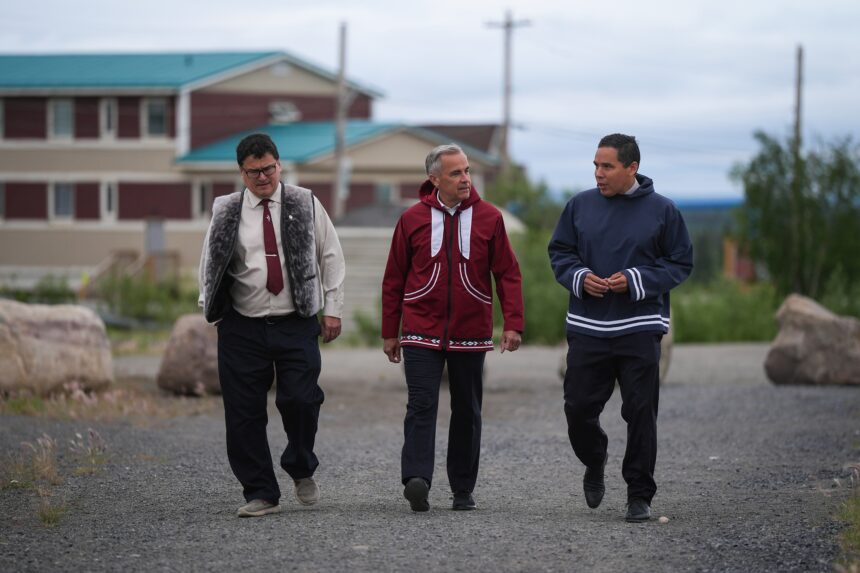The northern skies spread wide over Inuvik this Tuesday as Finance Minister Mark Carney stepped off a government jet and into what might be the most consequential consultation of his early tenure. While Ottawa summers blaze, the Northwest Territories offered a cooler backdrop for heated discussions about Bill C-5, the government’s ambitious major projects legislation that has drawn both praise and concern from Indigenous communities across Canada.
“We didn’t come north to tell people what we’re doing. We came to listen,” Carney told me as we walked from the small terminal building. The former Bank of Canada governor, looking somewhat out of place in his carefully rolled-up sleeves, was greeted by a delegation of Inuit leaders who have expressed growing concerns about how the bill’s promised economic benefits might affect their traditional lands and governance rights.
Natan Obed, president of Inuit Tapiriit Kanatami, who flew in from Iqaluit for the meetings, didn’t mince words during the public portion of discussions. “The spirit of reconciliation requires more than consultation after legislation is drafted. It demands partnership from the beginning,” Obed said, while acknowledging the government’s outreach efforts.
Bill C-5, introduced in Parliament last month, promises to streamline approvals for what the government calls “projects of national significance” – everything from critical minerals mining to clean energy infrastructure. The legislation has become the cornerstone of Carney’s economic vision since taking office, with the government claiming it could unlock over $30 billion in investment over the next decade.
For communities across Inuit Nunangat – the Inuit homeland comprising 35% of Canada’s landmass and 50% of its coastline – the stakes couldn’t be higher. The region holds vast deposits of minerals essential for green technology, including nickel, cobalt and rare earth elements. A recent Geological Survey of Canada report estimates the north could supply up to 40% of materials needed for North America’s energy transition.
Duane Smith, chair of the Inuvialuit Regional Corporation, pointed to specific concerns during Tuesday’s roundtable. “The bill’s current environmental review provisions don’t adequately address our unique Arctic ecosystems and the cultural practices tied to them,” Smith explained, referencing provisions in Section 28 that would accelerate environmental assessments for certain projects.
The meetings, held at Inuvik’s community centre, stretched nearly two hours longer than scheduled. Community members gathered outside, some holding signs expressing support for development, others demanding stronger protections. Rosemarie Kuptana, an elder from Sachs Harbour, told me, “We’ve seen promises before. What we need are guarantees our grandchildren will still have healthy land when these projects are finished.”
Carney, for his part, appeared to take the criticism seriously. Sources inside the meeting described the minister as “notably engaged,” taking extensive notes and asking detailed questions about Inuit governance structures. This marks a shift from previous consultations under the former government, which Inuit leaders often characterized as perfunctory.
“The North has always been treated as a resource colony,” said James Eetoolook, acting president of Nunavut Tunngavik Inc. “Minister Carney seems to understand that must change, but understanding and acting are different matters.”
The Finance Department’s own analysis, obtained through access to information requests, suggests Bill C-5 could fast-track at least eight major mining projects across the territories within 18 months of passing. This acceleration has raised alarms about whether proper environmental and cultural impact assessments can be maintained.
In a notable exchange during the public session, Carney acknowledged these concerns while defending the legislation’s core purpose. “Climate change is transforming the Arctic at twice the rate of southern Canada. The transition to clean energy is urgent, and Indigenous communities deserve to benefit from it,” the minister said. “But we recognize the path forward must respect rights, title, and self-determination.”
The Trudeau government’s relationship with Indigenous communities has been complicated. While making reconciliation a central policy pillar, critics point to continued legal battles over compensation for Indigenous children and slow progress implementing the UN Declaration on the Rights of Indigenous Peoples Act.
Polling suggests Canadians broadly support the bill’s economic aims, with an Abacus Data survey showing 68% favor accelerating clean energy and critical minerals projects. However, that support drops to 41% when respondents were asked if environmental standards should be relaxed to achieve those goals.
After the formal meetings, I spoke with Monica Ell-Kanayuk, president of the Inuit Circumpolar Council Canada, who emphasized the global context. “Russia’s Arctic resources are essentially off the market due to sanctions. Chinese companies are aggressively pursuing partnerships across the circumpolar north. Canada needs to get this right – not just for our economy but for sovereignty and security reasons.”
Walking back to his waiting transport under the midnight sun, Carney reflected on the day’s discussions. “This isn’t just about checking a consultation box. The insights shared today will directly influence amendments we’re considering before the bill returns to committee in September.”
Whether those amendments will satisfy Inuit concerns remains to be seen. The legislation faces several parliamentary hurdles, including potential Senate modifications that could delay implementation until early 2026. Meanwhile, international investors watch closely, weighing Canada’s regulatory environment against competing jurisdictions.
As Carney’s plane departed yesterday morning, Inuvik returned to its summer routines – fishing boats heading out on the Mackenzie River, construction crews racing to complete projects during the brief building season. For residents here, the high-level policy discussions represent real questions about their future: Will they benefit from the coming resource boom, or merely endure its consequences?
The answers may determine not just the fate of Bill C-5, but the government’s broader reconciliation agenda and Canada’s role in the global energy transition. As Obed put it before departing: “The true measure of this consultation isn’t what was said in Inuvik, but what changes in Ottawa.”






